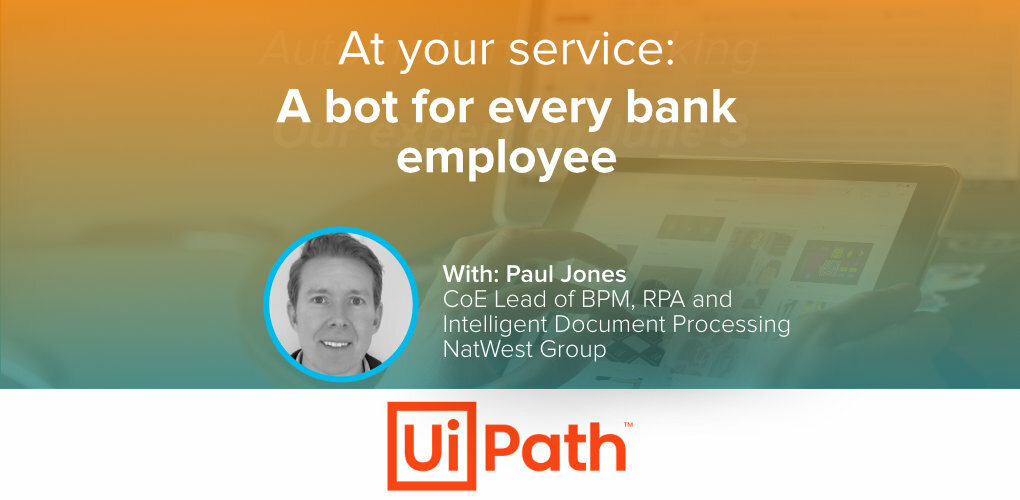
Insights & Opinions
At your service: A bot for every bank employee
Tue, 08 Jun 2021


The vision of a bank to have a bot for every employee has two critical implications: a bank continues to have a human workforce, and the robot will be working together with the employees, not in parallel or independently.
How realistic is it to have a bot for every employee? Can we imagine bots assisting C-level, helpdesk employees and everything in between? And what is required to make the vision a reality?
We invited Paul Jones, Head of Centre of Excellence BPM, RPA and Intelligent Document Processing at NatWest Group, to discuss whether a bot for every employee is a myth or a possible reality.
Attended bots at your service
Bots that work with people are what we call attended bots. They are your digital assistant within the desktop and can run services on your behalf.
The opposite is the unattended robot with its own credentials and ID that needs no human intervention but does its job on a scripted schedule somewhere at the back. Extraction and classification of information and data analysis are examples that are done mainly by unattended bots.
Suppose someone requires client information, an attended bot can do that for this person, often much faster than a human being can, especially if it involves multiple systems. Paul explained it as the robot taking over your desktop and screen, doing all the required tasks while you can do something else. So you are sitting in front of your screen, and it is like someone else is doing the work for you.
Imagine the call centre, where on average, 30% of the call time is silence because the agent is looking for things. Paul: "I could run attended automation to do all that for me. Rather than putting the customer on hold and listening to music for a couple of minutes, you talk to the customer to hear more about their interests. So you can get the bot to run searches for the client while you focus on more interesting, more value-adding activities, more direct customer communication, those sort of scenarios."
Attended bots will help the organisation save time and money, but it will primarily increase employee satisfaction and, for employees with direct customer contact also increase customer satisfaction.
From project managers to CEOs: a virtual assistant for everyone
The contact centre is the most concrete example of virtual assistants helping employees to better manage their work in real-time. As the conversation continued, more examples popped up.
Someone in the audience joined the conversation by saying this kind of automation could have saved them a lot of time and frustration in the project management team. She estimated that 50% of her time spent was on standard documentation. A virtual assistant would be a great support, not only to reduce time and costs but also to avoid human errors and to increase employee delight. After all: project management is a people business, not a reporting business.
Nicolas Boitout, CoE Lead AI, Analytics & Automation at Société Générale Global Shared Services Centre, you may remember him from a previous session, joined the table explaining they use it predominantly for analytics:
"When you need to understand how your process works, you need to compute data, collect data that are unique from different sources, aggregate them in a spreadsheet. That spreadsheet may be hosted somewhere else, in an operational database, or even another data lake. We want to do this with our attended RPA."
Paul's second more favourite case, after contact centres, was the finance department. They have used macros in excel, VBA and other toolings to automate whatever possible. A virtual assistant is a logical next step, in his opinion, to further streamline what they built over the years.
How about the sale team? By having a virtual assistant manage their planning, they could have more time to do what they are good at, that is: speaking to people and selling products and services. Beyond that, RPA solutions have the opportunity to overcome the challenge of multiple CRM tools because of an organisation's history of mergers and acquisitions.
Paul: "Over the years, many organisations face legacy systems. It's very uncommon for us to have the fortune to work in an organisation where everything's perfect. So what invariably happens is that you use RPA, as what I would call a strategically tactical tool."
Apart from the operational and tactical jobs, someone even mentioned that their CEO uses a bot to help with reporting. So yes, in a way, you can say there is an opportunity for every employee to have their own bot.
No personal virtual assistants without a personal touch
The idea behind RPA-based virtual assistants and their value is that an organisation's business can avoid the bumpy road of passing through IT to get things done. Someone said: "If you want to benefit from an RPA bot, you need to do that on your own."
Take the example of NatWest Group, which has a federated model with one centre of excellence and multiple technical teams across the organisation. These technical teams own the development of bots, which works well in the context of unattended bots. But Paul acknowledged that this setup is currently a constraint to make a bot for every employee a reality.
"If you're going to have a bot for every employee, and you're going to roll out attended automation to everybody, well, actually they are going to have to develop bots themselves. So realistically, it's not a scenario where there'll be a central team."
Evolving to a model with citizen developers who develop their own attended automation brings a whole new set of challenges, particularly in terms of governance. The technology can easily be trained to non-technical people, that is not a concern. The question is how to govern the model across the organisation.
"The thing that strikes the fear into the heart of the technology is operations and business functions running business processes on what we call end user-developed tools and solutions", Paul explained, but today's model is not sustainable in the context of attended robots: "Either the model will kill the idea, or the model will have to change for it to happen."
Conclusion
A bot for every employee, a reality of myth? Today it is a myth, but this session clearly showed that it is a realistic dream for the near future, if there is the will to achieve it. It will require plenty of change from a human, technological, and governance standpoint, but the upside is a happier customer, a more energised workforce, and a more efficient organisation overall.
Make sure you free your agenda on September 9th, when we welcome Chris Skinner, author and commentator at The Finanser and Nitin Purwar, Director Banking Industry Practice at UiPath to discuss "Automation for Good: Automation as an enabler for ESG and Sustainability in Banks."



